2004 SUBARU IMPREZA WRX ECU
[x] Cancel search: ECUPage 42 of 491
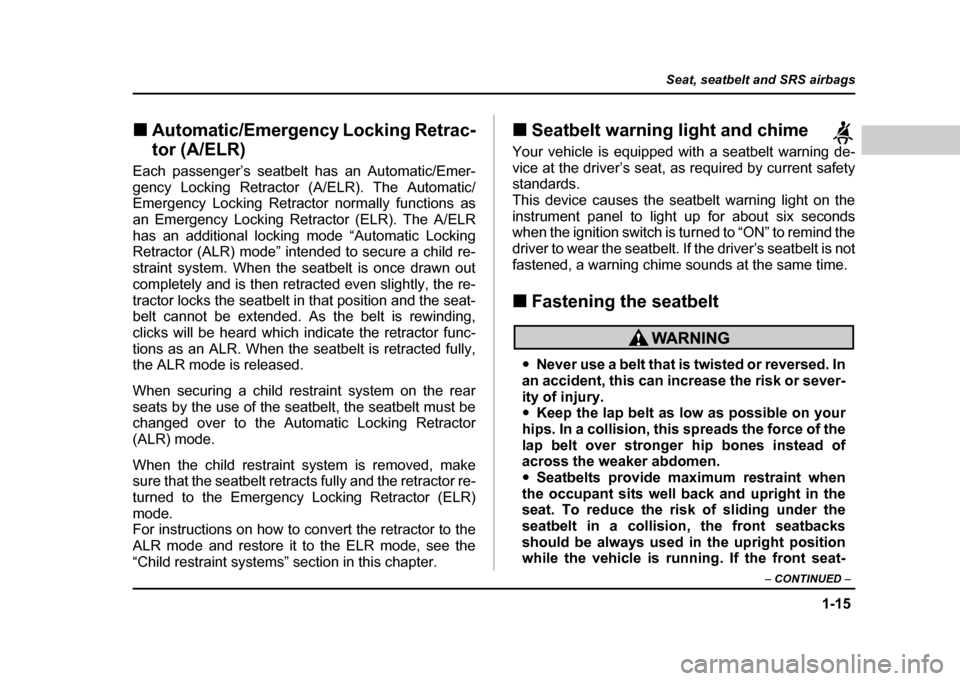
1-15
Seat, seatbelt and SRS airbags
– CONTINUED –
!Automatic/Emergency Locking Retrac- tor (A/ELR)
Each passenger’s seatbelt has an Automatic/Emer-
gency Locking Retractor (A/ELR). The Automatic/
Emergency Locking Retractor normally functions as
an Emergency Locking Retractor (ELR). The A/ELR
has an additional locking mode “Automatic Locking
Retractor (ALR) mode” intended to secure a child re-
straint system. When the seatbelt is once drawn out
completely and is then retracted even slightly, the re-
tractor locks the seatbelt in that position and the seat-
belt cannot be extended. As the belt is rewinding,
clicks will be heard which indicate the retractor func-
tions as an ALR. When the seatbelt is retracted fully,
the ALR mode is released.
When securing a child restraint system on the rear
seats by the use of the seatbelt, the seatbelt must be
changed over to the Automatic Locking Retractor (ALR) mode.
When the child restraint system is removed, make
sure that the seatbelt retracts fully and the retractor re-
turned to the Emergency Locking Retractor (ELR)
mode.
For instructions on how to convert the retractor to the
ALR mode and restore it to the ELR mode, see the
“Child restraint systems” section in this chapter. !
Seatbelt warning light and chime
Your vehicle is equipped with a seatbelt warning de-
vice at the driver’s seat, as required by current safety
standards.
This device causes the seatbelt warning light on the
instrument panel to light up for about six seconds
when the ignition switch is turned to “ON” to remind the
driver to wear the seatbelt. If the driver’s seatbelt is not
fastened, a warning chime sounds at the same time. ! Fastening the seatbelt
"Never use a belt that is twisted or reversed. In
an accident, this can increase the risk or sever-
ity of injury. " Keep the lap belt as low as possible on your
hips. In a collision, this spreads the force of the
lap belt over stronger hip bones instead of
across the weaker abdomen. " Seatbelts provide maximum restraint when
the occupant sits well back and upright in the
seat. To reduce the risk of sliding under the
seatbelt in a collision, the front seatbacks
should be always used in the upright position
while the vehicle is running. If the front seat-
Page 58 of 491
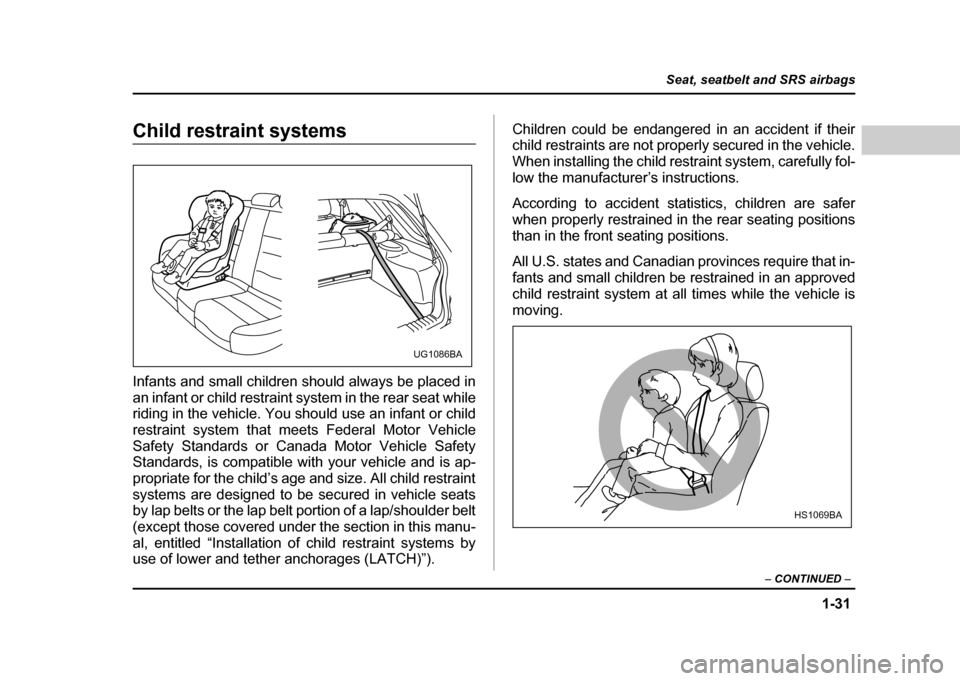
1-31
Seat, seatbelt and SRS airbags
– CONTINUED –
Child restraint systems
Infants and small children should always be placed in
an infant or child restraint system in the rear seat while
riding in the vehicle. You should use an infant or child
restraint system that meets Federal Motor Vehicle
Safety Standards or Canada Motor Vehicle Safety
Standards, is compatible with your vehicle and is ap-
propriate for the child’s age and size. All child restraint
systems are designed to be secured in vehicle seats
by lap belts or the lap belt portion of a lap/shoulder belt
(except those covered under the section in this manu-
al, entitled “Installation of child restraint systems by
use of lower and tether anchorages (LATCH)”). Children could be endangered in an accident if their
child restraints are not properly secured in the vehicle.
When installing the child restraint system, carefully fol-
low the manufacturer’s instructions.
According to accident statistics, children are safer
when properly restrained in the rear seating positions
than in the front seating positions.
All U.S. states and Canadian provinces require that in-
fants and small children be restrained in an approved
child restraint system at all times while the vehicle ismoving.
UG1086BA
HS1069BA
Page 60 of 491
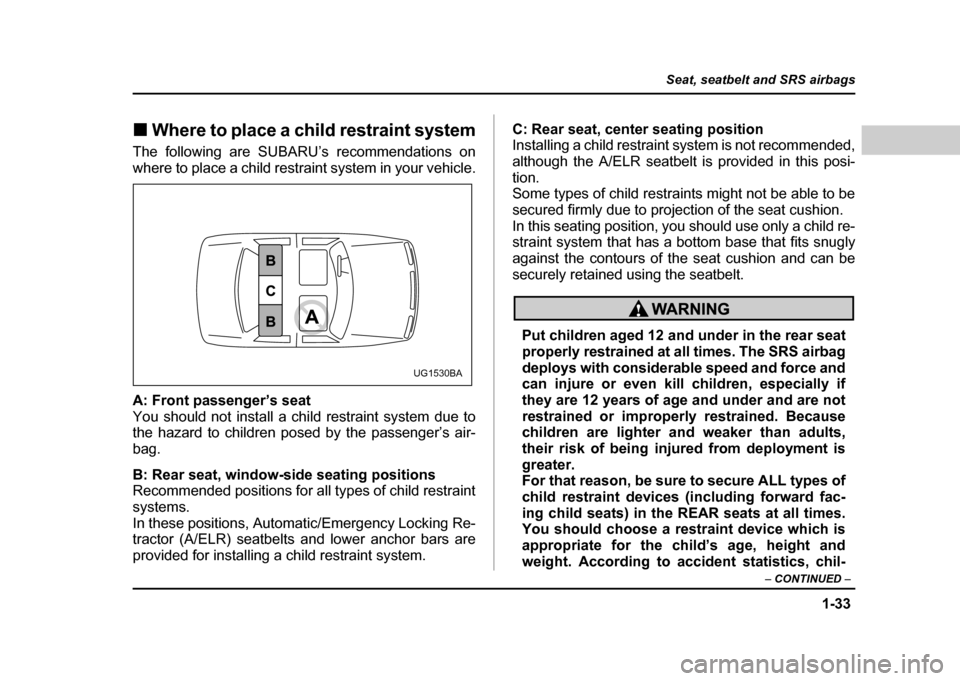
1-33
Seat, seatbelt and SRS airbags
– CONTINUED –
!Where to place a child restraint system
The following are SUBARU’s recommendations on
where to place a child restraint system in your vehicle.
A: Front passenger’s seat
You should not install a child restraint system due to
the hazard to children posed by the passenger’s air-
bag.
B: Rear seat, window-side seating positions
Recommended positions for all types of child restraint systems.
In these positions, Automatic/Emergency Locking Re-
tractor (A/ELR) seatbelts and lower anchor bars are
provided for installing a child restraint system. C: Rear seat, center seating position
Installing a child restraint system is not recommended,
although the A/ELR seatbelt is provided in this posi-
tion.
Some types of child restraints might not be able to be
secured firmly due to projection of the seat cushion.
In this seating position, you should use only a child re-
straint system that has a bottom base that fits snugly
against the contours of the seat cushion and can be
securely retained using the seatbelt.
Put children aged 12 and under in the rear seat
properly restrained at all times. The SRS airbag
deploys with considerable speed and force and
can injure or even kill children, especially if
they are 12 years of age and under and are not
restrained or improperly restrained. Because
children are lighter and weaker than adults,
their risk of being injured from deployment is
greater.
For that reason, be sure to secure ALL types of
child restraint devices (including forward fac-
ing child seats) in the REAR seats at all times.
You should choose a restraint device which is
appropriate for the child’s age, height and
weight. According to accident statistics, chil-
UG1530BA
Page 62 of 491
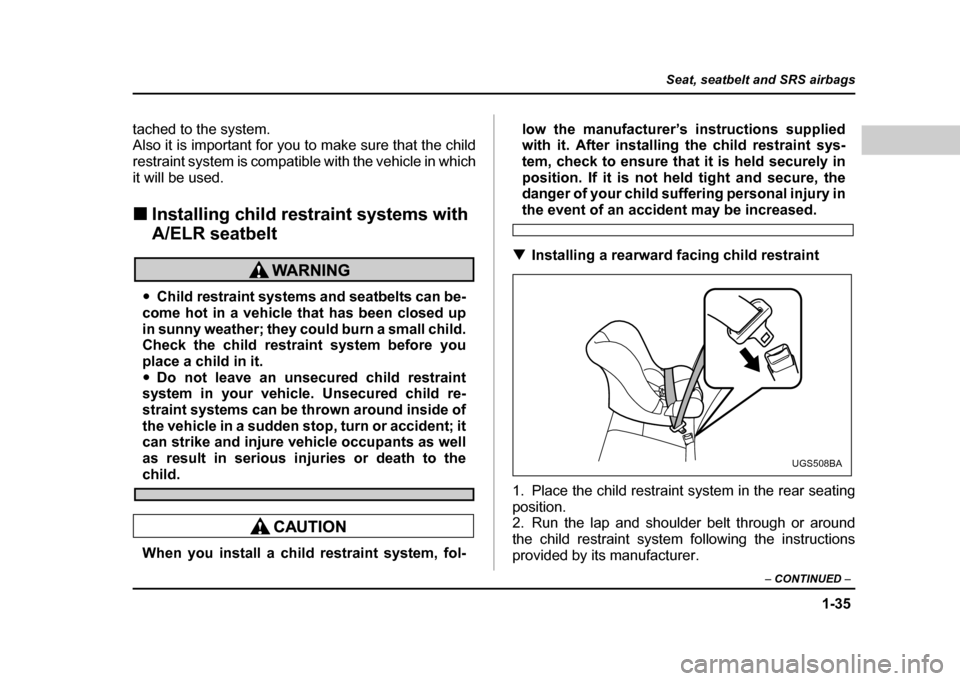
1-35
Seat, seatbelt and SRS airbags
– CONTINUED –
tached to the system.
Also it is important for you to make sure that the child
restraint system is compatible with the vehicle in which
it will be used. !Installing child restraint systems with
A/ELR seatbelt
"Child restraint systems and seatbelts can be-
come hot in a vehicle that has been closed up
in sunny weather; they could burn a small child.
Check the child restraint system before you
place a child in it." Do not leave an unsecured child restraint
system in your vehicle. Unsecured child re-
straint systems can be thrown around inside of
the vehicle in a sudden stop, turn or accident; it
can strike and injure vehicle occupants as well
as result in serious injuries or death to the
child.
When you install a child restraint system, fol- low the manufacturer’s instructions supplied
with it. After installing the child restraint sys-
tem, check to ensure that it is held securely in
position. If it is not held tight and secure, the
danger of your child suffering personal injury in
the event of an accident may be increased.
! Installing a rearward facing child restraint
1. Place the child restraint system in the rear seating
position.
2. Run the lap and shoulder belt through or around
the child restraint system following the instructions
provided by its manufacturer.
UGS508BA
Page 63 of 491
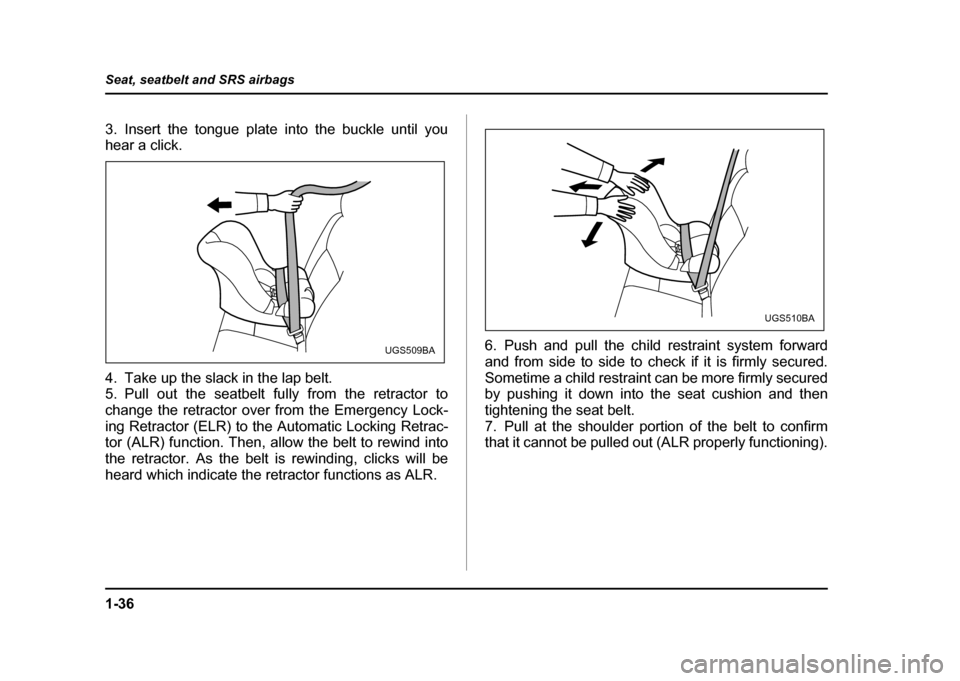
1-36
Seat, seatbelt and SRS airbags
3. Insert the tongue plate into the buckle until you
hear a click.
4. Take up the slack in the lap belt.
5. Pull out the seatbelt fully from the retractor to
change the retractor over from the Emergency Lock-
ing Retractor (ELR) to the Automatic Locking Retrac-
tor (ALR) function. Then, allow the belt to rewind into
the retractor. As the belt is rewinding, clicks will be
heard which indicate the retractor functions as ALR.
6. Push and pull the child restraint system forward
and from side to side to check if it is firmly secured.
Sometime a child restraint can be more firmly secured
by pushing it down into the seat cushion and then
tightening the seat belt.
7. Pull at the shoulder portion of the belt to confirm
that it cannot be pulled out (ALR properly functioning).
UGS509BA
UGS510BA
Page 65 of 491
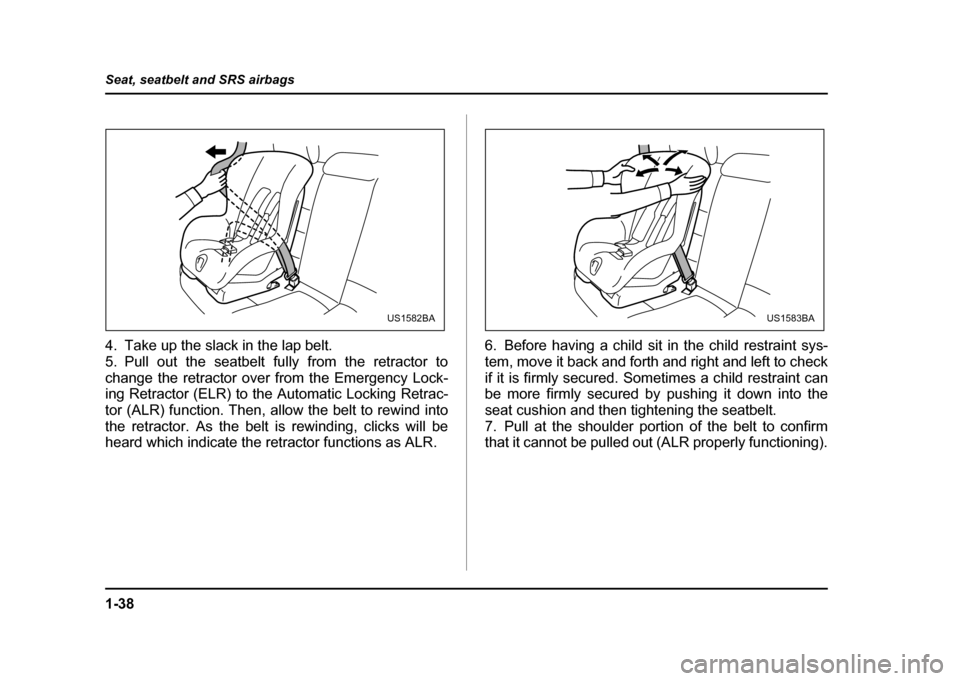
1-38
Seat, seatbelt and SRS airbags
4. Take up the slack in the lap belt.
5. Pull out the seatbelt fully from the retractor to
change the retractor over from the Emergency Lock-
ing Retractor (ELR) to the Automatic Locking Retrac-
tor (ALR) function. Then, allow the belt to rewind into
the retractor. As the belt is rewinding, clicks will be
heard which indicate the retractor functions as ALR.
6. Before having a child sit in the child restraint sys-
tem, move it back and forth and right and left to check
if it is firmly secured. Sometimes a child restraint can
be more firmly secured by pushing it down into the
seat cushion and then tightening the seatbelt.
7. Pull at the shoulder portion of the belt to confirm
that it cannot be pulled out (ALR properly functioning).
US1582BAUS1583BA
Page 67 of 491
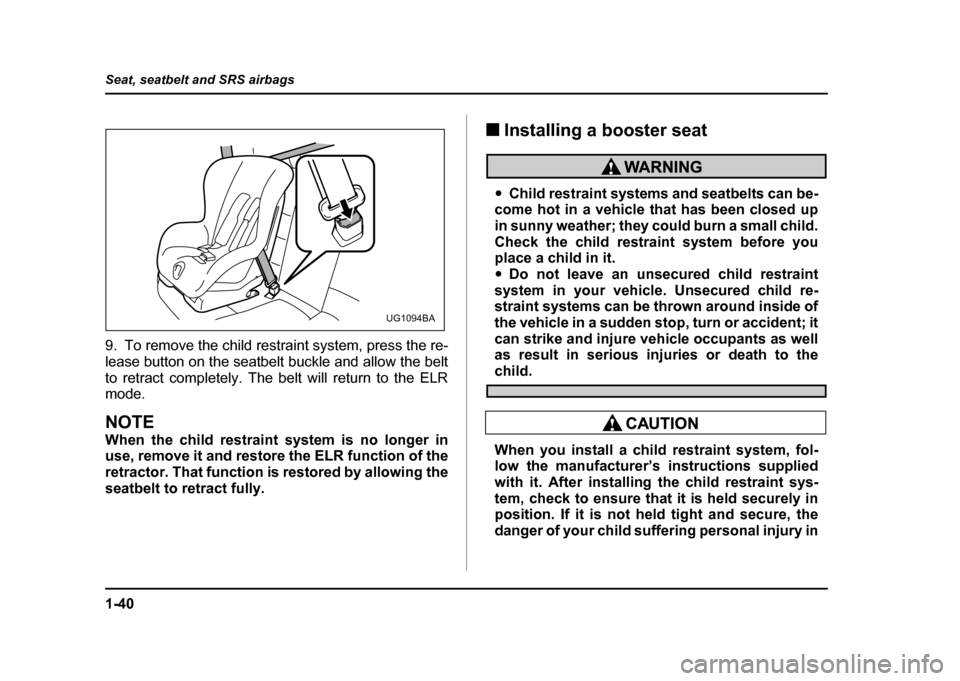
1-40
Seat, seatbelt and SRS airbags
9. To remove the child restraint system, press the re-
lease button on the seatbelt buckle and allow the belt
to retract completely. The belt will return to the ELR
mode.
NOTE
When the child restraint system is no longer in
use, remove it and restore the ELR function of the
retractor. That function is restored by allowing the
seatbelt to retract fully.
!
Installing a booster seat
"Child restraint systems and seatbelts can be-
come hot in a vehicle that has been closed up
in sunny weather; they could burn a small child.
Check the child restraint system before you
place a child in it. " Do not leave an unsecured child restraint
system in your vehicle. Unsecured child re-
straint systems can be thrown around inside of
the vehicle in a sudden stop, turn or accident; it
can strike and injure vehicle occupants as well
as result in serious injuries or death to the
child.
When you install a child restraint system, fol-
low the manufacturer’s instructions supplied
with it. After installing the child restraint sys-
tem, check to ensure that it is held securely in
position. If it is not held tight and secure, the
danger of your child suffering personal injury in
UG1094BA
Page 69 of 491
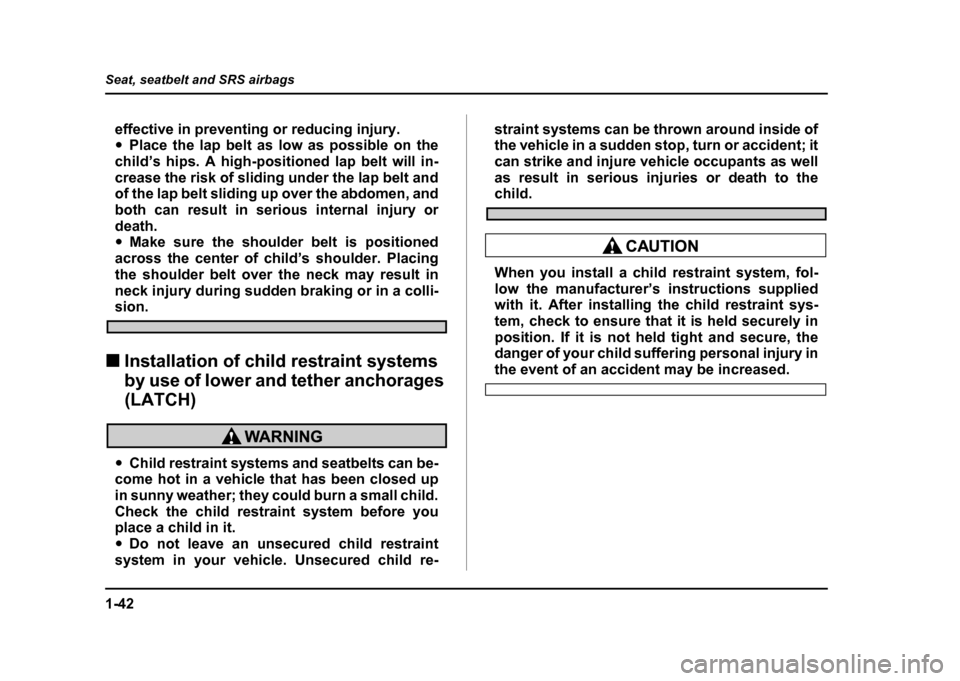
1-42
Seat, seatbelt and SRS airbags
effective in preventing or reducing injury. "
Place the lap belt as low as possible on the
child’s hips. A high-positioned lap belt will in-
crease the risk of sliding under the lap belt and
of the lap belt sliding up over the abdomen, and
both can result in serious internal injury or
death. " Make sure the shoulder belt is positioned
across the center of child’s shoulder. Placing
the shoulder belt over the neck may result in
neck injury during sudden braking or in a colli-
sion.
! Installation of child restraint systems
by use of lower and tether anchorages (LATCH)
"Child restraint systems and seatbelts can be-
come hot in a vehicle that has been closed up
in sunny weather; they could burn a small child.
Check the child restraint system before you
place a child in it. " Do not leave an unsecured child restraint
system in your vehicle. Unsecured child re- straint systems can be thrown around inside of
the vehicle in a sudden stop, turn or accident; it
can strike and injure vehicle occupants as well
as result in serious injuries or death to the
child.
When you install a child restraint system, fol-
low the manufacturer’s instructions supplied
with it. After installing the child restraint sys-
tem, check to ensure that it is held securely in
position. If it is not held tight and secure, the
danger of your child suffering personal injury in
the event of an accident may be increased.